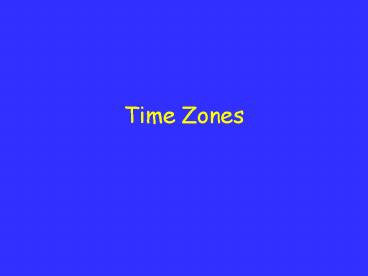Time Zones - PowerPoint PPT Presentation
1 / 13
Title:
Time Zones
Description:
Time Zones ... world would be divided into 24 equal time zones (as convention had 24 hours in a ... and therefore each time zone would be 15 wide (360/24 = 15) ... – PowerPoint PPT presentation
Number of Views:2358
Avg rating:5.0/5.0
Title: Time Zones
1
Time Zones
2
- in early days everyone set their clocks according
to the sun - it was noon (1200 p.m.) when the
sun was at its highest point (its "zenith") in
the sky - in larger communities, the military often would
fire off a gun to signal this occurrence and
everyone would reset their watches or, they
would listen for the tolling of the clock in town
hall
3
(No Transcript)
4
- because the length of daylight changes a little
each day with the change in seasons, the length
of time from solar noon to solar noon is not
exactly 24 hours - as commerce developed, and railways and then
telegraph communication became more widespread,
this use of solar time became very difficult as
each town had a slightly different solar time
(because the sun is not overhead all places at
the same time)
5
- conductors on trains often had ludicriously
complicated jobs, trying to keep track of the
correct time in various small communities as they
tried to keep the trains running on time
http//www.honorpub.com/graphics/time.gif
6
- in 1886 the international community adopted a
series of measures that solved this and other
vexing navigational problems at a huge conference
in Berlin (this was when all of Europe was at
peace - a rare occurrence - an international
agreement could be possible)
http//www.labcompliance.com/berlin/berlin.jpg
7
- a Canadian, Sir Sandford Fleming, devised the
notion of what became known as "standard time - it depended on a consistent system of latitude
and longitude
- latitude was easy - the equator was 0º and math
determined the rest - but where is the 0º line
for longitude - it could go anywhere, and
different countries thought it should be through
their country
www.arvadesign.ca/narhf/nar01/ NAR01awards_fleming
.html
8
- in 1886 the world agreed that it should pass
through Greenwich, England (outside London) as
this was where a very important observatory was
located - this is called the Prime (or "first")
Meridian of longitude
http//gauss.gge.unb.ca/grads/sunil/homepage/photo
s/greenwich2.gif
9
- it was further agreed that the world would be
divided into 24 equal time zones (as convention
had 24 hours in a day)
http//www.suffolkcc.gov.uk/transport/graphics/24h
r_clock.gif
10
- since the world is round, there would be
therefore 360º of longitude - and therefore each time zone would be 15º wide
(360/24 15) - in each of these time zones everyone would adopt
the same time and as you crossed from one time
zone to another you changed your watch by one
full hour
11
Time Zones
12
Time Zones
13
- this was a huge improvement on the old system and
it was quickly adopted - the agreement also allowed for nations to alter
the borders of each time zone somewhat so that
places that have a lot to do with one another
could be in the same time zone for convenience
sake - there were some other variations as well, eg.
Newfoundland time































